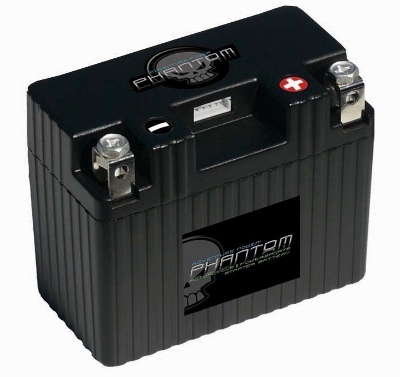| Home | Rides | Reviews | Bikes | Gallery | Tech | Misc | Contact |
| Phantom Powersports
Battery By Martin Hackworth Unfortunately, another one bites the dust... Photo: Universal Power Group |
 |
|
|
|
We've previously sung the praises of lightweight Lithium-Ferrous batteries, such as the Ballistic Performance Components EVO 2 Lithium-Ion 8 cell. Like other LiFePO4 batteries, the Phantom is less than half the weight of a conventional sealed lead-acid unit, yet it possesses both superior energy storage and cold cranking power. As far as any of us can tell, the Phantom battery is a Shorai with a different sticker on the case. Specs and construction between the two are virtually identical. There's even mention of Shorai technology in literature associated with the Phantom. The only difference seems to be the cost. Phantom batteries, like Shorai and EVO, use lithium ferrous technology, which has the ability to store tremendous amounts of energy per unit weight. The prismatic cells in the Phantom are said to be specifically engineered for starting applications in powersports: motorcycles, ATVs, etc., as opposed to being designed primarily to power hand tools such as drills and saws. The cells are housed in a military-spec carbon composite case that is very durable. Since the cells are dry, the battery may be mounted in any position - and there's nothing to leak even if the case were to be compromised. Cold cranking power for the APP14L2-BS12, a battery that fits a variety of large dirt bikes, is 210 amps (compared to 130 for the OEM YUASA, and 275 for the EVO 2). The starter motor winds up with discernibly more authority with the Phantom in place than with a YUASA lead-acid. The Phantom requires no trickle charger, and will lose less than 10% of its static charge over an entire year, with no maintenance. The Phantom may be charged with a standard automotive charger as long as it has an automatic full-charge cutoff. The Phantom comes with a limited 1-year warranty. The performance of all lithium-ferrous batteries falls off in cold temperatures, and Phantom does not recommend their batteries for extended use in temperatures below freezing. One thing that we learned from our ace battery pro, Scott Hardenbrook, of Battery Systems, is that LiFePO4 batteries have the ability to generate internal heat at lower temperatures. When the weather is cool, I turn on my Trail Tech X2 for about 5 seconds prior to starting the bike. While the battery is supplying current to the lights, it's internal resistance diminishes, it heats up, and it performs, after a few seconds, just like it should in warmer temperatures. The Phantom is not exactly a drop in OEM replacement. The terminals on all Phantoms are sufficiently different than OEM as to require relocation of the stock cables (at least on the CRF450X). Care must be taken not to ground the positive terminal against the frame (the resulting damage would not be covered under warranty). Nonetheless, all of this took only 20 minutes and required nothing more special than zip ties and a bit of padding (supplied). |
|
It's true that our CRF450X cranked over
much more rapidly than with a lead battery and our 100-watt HID
lighting system ran at idle longer. It's also true that, power aside,
nothing sells a
Lithium Ferrous battery quite like holding one in your
hand. Low weight,
superior cranking power, almost no maintenance, easy
recyclability and competitive pricing make
these very attractive when it's time to replace your current
lead battery. In our experience, however, all LiFePO4 batteries are
alike in one major regard - long term real life performance vs specs. After 11 months of use, our first LiFePO4 battery, a Ballistic EVO 2, wouldn't hold sufficient charge. We exchanged the EVO 2 battery for a new one without a bit of hassle. Unfortunately the second battery also went dead about six months later. In both cases, the battery went bad after a few weeks of not being used and would then not hold a full charge. The second time we had a much more difficult time with having the battery replaced under warranty. Our Phantom, which we obtained after our second EVO 2 failed prematurely, held up well for a few months before requiring replacement under warranty. Our second Phantom also failed prematurely (in our opinion). The replacement for it was dead when we got it out of the box. All of us here have come to the conclusion that LiFePO4 batteries are just too fragile - both in terms of performance and manufacturing tolerance. You might, for instance, get a good one that performs the way that it ought to so long as long as you do not subject it to extremes of temperature, or drain it. But we've collectively gone through dozens of these, from several manufacturers, and found that rarely do they perform up to specs. As much as I hate the static weight, and increased moment of inertia, I've recently gone back to the old standby YAUSA, and have had not even a hint of a problem since. YMMV. |
Specifications: Phantom APP14L2-BS12 Battery Dimensions: 113mm x 58mm x 89mm Weight: 663 grams, 1 lb 7 oz Voltage (charged): 14.4 Volts Amperage: 14 Amp Hours (Lead-Acid Equivalent) Cold Cranking Amps: 210 Amps Operating Environment: 0o F to 140o F The Good: Lighter than a lead battery - by a fair amount. The Rad: Specs vs. the real world - YMMV. The Gnarly: Another one bites the dust. Price Paid: $159.95, Pocatello Power Sports |
| Home | Rides | Reviews | Bikes | Gallery | Tech | Misc | Contact |
